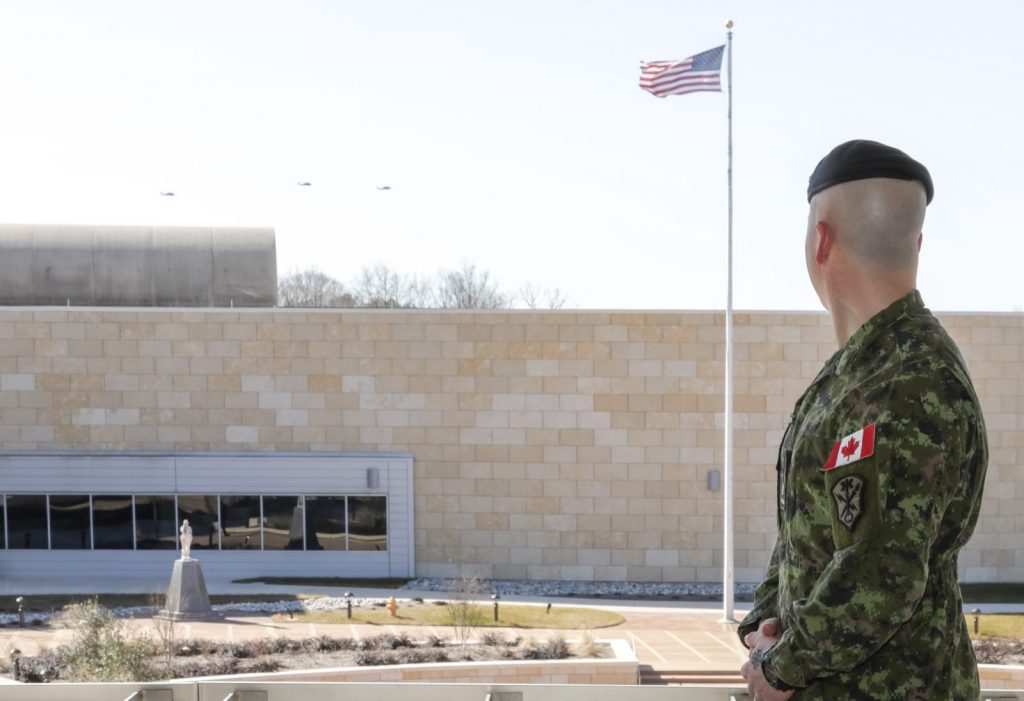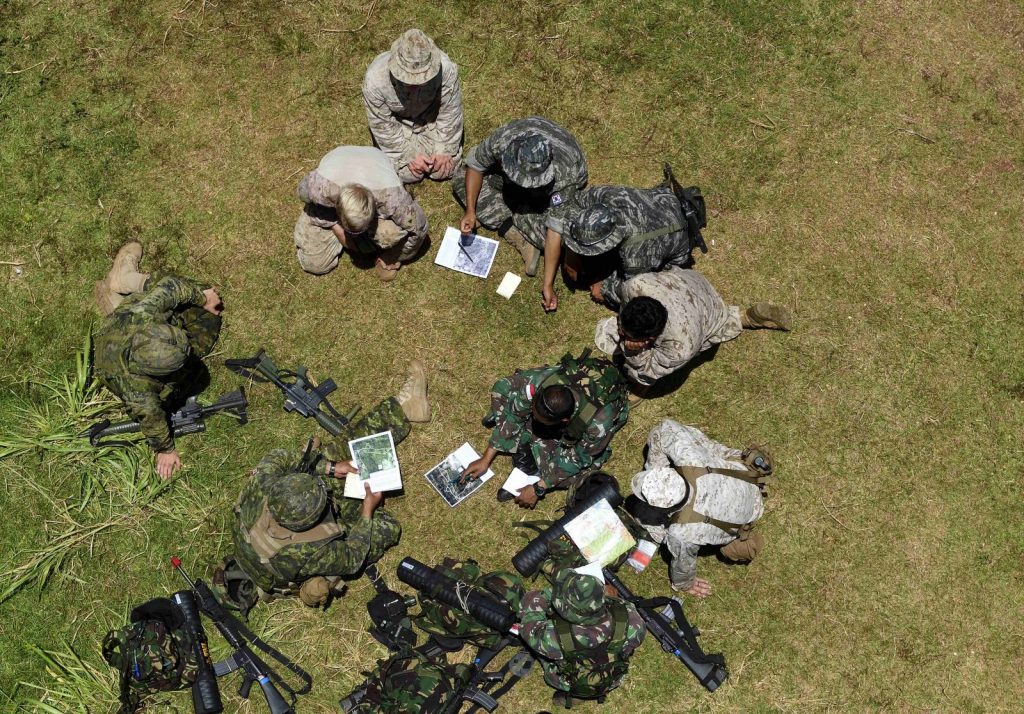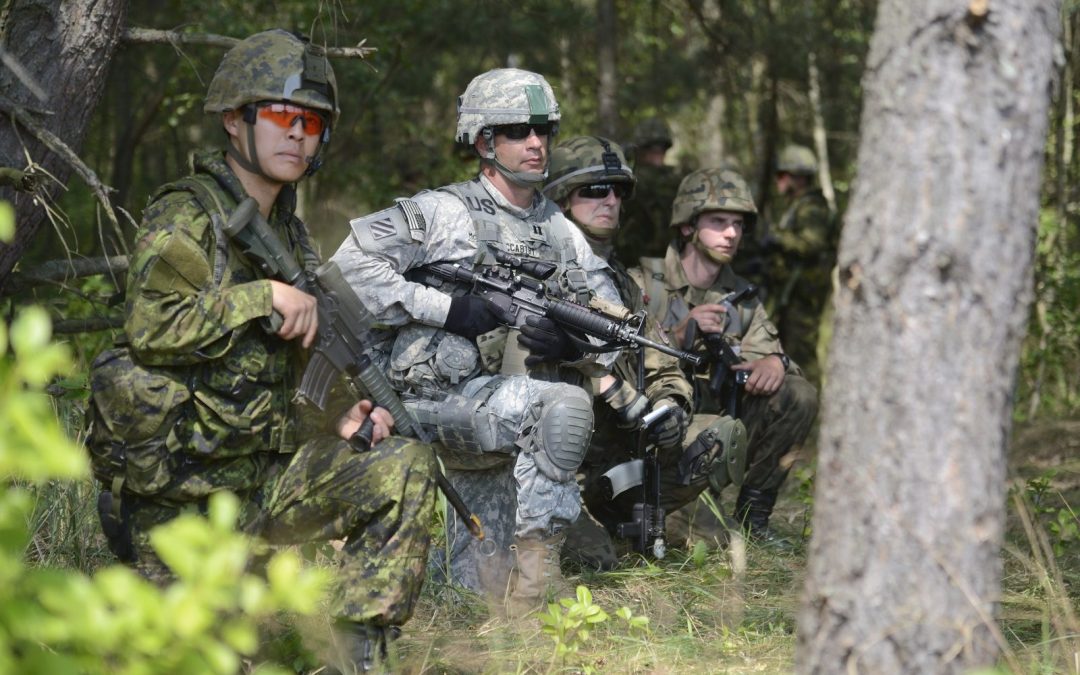As part of its modernization strategy the Army will realign exchange and liaison officers to meet its engagement priorities. Here are five principles for leadership as an Army liaison officer.
by Major Bradley E. Benns
Leadership, in all forms, is the most critical capability of any military force. As members of the Canadian Army, we have the privilege of leading others in a variety of environments, from simple garrison duties that test the mundane administration of our forces to international or domestic operations, which allow us to execute national objectives in war fighting, security or humanitarian assistance. Regardless of the position, the Army offers a plethora of tangible leadership opportunities in which personnel of all ranks and experience can excel.
Although these examples are straightforward in the application of leadership, there are other positions that demonstrate less obvious opportunities. Leadership as a liaison officer is one of those unique positions.
Given Canada’s reliance on and integration with our allies, the continuity of effort in military partnerships with the Five Eyes and NATO communities are particularly important. Liaison officers are placed in key locations across our allied network as lone representatives to influence the outcomes of Canadian objectives. This network of officers helps to achieve national efforts in joint operations, training or capability development. Although the application of leadership is far less tangible than conducting a company attack on an overseas objective, liaison officers lead Canadian functional objectives supporting common allied goals.
Through the benefit of historical relationships and integration with our partners, the provision of clear national objectives in our current priorities, and the development of enduring reciprocal engagements into the future, Canada can demonstrate an essential capability through partnerships. Critical to national success, effective liaison provides immeasurable leadership value to long-term military collaboration.
EYES AND EARS
The leadership of military liaison officers was a critical function during the Second World War. Although their roles were quite different during an active campaign, the presence of liaison officers helped legitimize the function. Considering the complexities of moving large forces against Germany in Western Europe, Field-Marshall Bernard Montgomery, Land Force Commander of Allied Forces in Western Europe on D-Day, created forward liaison officer positions in each of his Armies. Tasked with reporting near real-time activities, these officers acted as key information nodes to planners and commanders, extending Montgomery’s “eyes and ears” into the battlefield.
The British, American, Canadian, French, and Polish Armies all had liaison officers in their Corps Headquarters throughout the campaign in Western Europe. This ensured that Montgomery was immediately informed of both successes and failures in order to allocate resources and manpower accordingly. Hand-picked, decorated officers provided an essential function that enabled success in the allied advance.
Establishing enormous trust with their commanders, Montgomery’s liaison officers were recognized for their leadership at the highest levels, their achievements reaching Prime Minister Winston Churchill. For these men in a time of war, the liaison function was critically important for the overall advance of Allied Forces in Europe. Their capabilities were a proven asset which enabled the 21st Army Group and they represent an excellent example of leadership in the position of liaison.
Another important historical example is the appointment of Field-Marshall Sir John Dill as the senior British military representative to the United States in late 1941. Dill had an incredible impact on the policies and relations between British and American leadership throughout the war. He established himself in a diplomatic role where he sought to overcome minor differences and lead both nations to pursue larger objectives in international policy. His focus was to understand the Americans, to lead with the best approach for gaining wartime resources and agreeing on military strategy with Great Britain. He took the time to know his allies and is credited with the ability to break down issues and achieve results for both countries.

Major Bradley E. Benns
CRITICAL LINKS
Given the importance of long-term, reciprocal relationships with our partners, we continue to foster personal and professional connections abroad. Providing opportunities for liaison officers with foreign militaries has helped to develop relationships, explore capabilities, and most of all, create a common understanding for future engagements. As a Canadian representative to the United States Army Intelligence and Security Command (INSCOM) in Fort Belvoir, Va., I am charged with establishing critical links to enable Canada’s intelligence community.
Hosting the gamut of U.S. Army Intelligence capabilities, INSCOM is an essential partner in realizing our national objectives. Whilst Canadians seek to contribute to U.S. efforts in training, operations, and capability development, we learn from these partnerships daily. Leading this relationship is an incredible undertaking I am humbled to be a part of. The potential of the position is enormous, and its practical applications promote significant opportunities for Canadian intelligence.
This role truly represents the ability to influence with direct and indirect leadership, serving to enhance our collective intelligence environment. Shared desires in both nations which are focused on internal changes in structures, functions, and capabilities provide an excellent opportunity for renewed commitment to liaison tasks.
The Canadian Army Modernization Strategy provides a litany of potential projects. Using this keystone document to direct liaison efforts generates focused and fulsome engagements on a variety of operational and functional tasks. As U.S. Forces also seek to modernize technology, equipment and capabilities, our efforts are linked to a common goal in national security and international peace. Canada employs dozens of junior and senior officers throughout the Five Eyes and NATO communities to ensure that priority efforts in all functional areas are well led, integrated, and implemented with partners. The mutual focus on modernization adds significant relevance to our efforts and liaison is vital to ensure a common way forward.
Leading Canadian efforts with INSCOM has far wider implications than just within the Canadian Intelligence Corps. U.S. Army intelligence capabilities span the breadth of the Canadian Armed Forces (CAF), with touch points across the Joint Forces space in Canadian Forces Intelligence Command (CFINTCOM), Canadian Joint Operations Command, and Special Operations Forces Command. All levels of Canadian capabilities and environments are influenced by the scope of INSCOM. Although our relationship is Army centric, it is essential that the wider CAF audience support our efforts to synchronize critical capabilities with our partners. With increased importance placed on the results of Canada’s internal Defence Intelligence Enterprise Renewal reports, our relationship is even more valuable.
FIGHTING WITH ALLIES
The future of liaison officers helping to lead national efforts will only increase in scope and importance.
Canada will need to ensure its political and military relationships endure, as they have for generations, fostering physical and economic security. Although there is a current trend to criticize individual and national differences throughout society, a focus on shared goals and outcomes remains the priority of military leadership.
Despite many differences, Prime Minister Winston Churchill stated, “there is only one thing worse than fighting with allies, and that is fighting without them.” Churchill understood that relationships can weather differences and that challenges will always exist. The creation of NATO in 1949 was founded upon a collection of aims from partner nations. Although member countries were not wholly united in their reasons for joining the organization, it nonetheless resulted in an appropriate framework to deliver the most positive collective results despite a variation in national objectives.
The critical factor in alliances is to consider long-term, attainable goals. Leadership in liaison is not about making friends at the cost of national aims; it is about creating the avenues of approach where divergent opinions can result in a unity of effort. Even the most powerful country in history needs partners. When former U.S. Secretary of Defense, General James Mattis, suggested that history demonstrates “nations with allies thrive, and those without them die,” he was speaking from a position of strength in unity, not of dependency on partners. Leading in liaison is a small, but important piece of our national effort in the global framework.

Canadian Major Hugh Atwell, Company Commander for Combat Landing Team 5, presents orders to representatives from U.S. Marines, Indonesian Marines and Republic of Korea Marines at Kahuku Training Area Hawaii for non-combatant evacuation operation training during Exercise Rim of the Pacific (RIMPAC) on July 27, 2014. Photo: Sgt Matthew McGregor
FIVE LEADERSHIP PRINCIPLES
From my personal experiences in working with partner nations, I offer the following five principles for leadership in liaison aimed at improving focus, communication, and outcomes of our collective efforts. Although only a short list of considerations, these principles will help provide context to the challenges in liaison.
Understand Your Ally: Understanding one’s allies can be just as important as understanding your adversary. We spend significant time and resources dissecting enemy strengths, weaknesses and capabilities, but tend to take our allies for granted. Despite our shared history, our close geography, or our cultural linkages, to assume that we will approach problems in the same manner is an error. A common history does not mean a common future. Understanding how our allies will react to international threats, their expectations of partner forces, and domestic political and cultural motivations, will serve to create far better synergy in partnerships.
Pursue Clear National Objectives: Liaison officers must understand their own objectives from a national perspective. This should include the ability to support Lines of Effort with national resources rather than develop new ideas without the possibility of moving them forward. The focus of any leader’s effort must equal the possibility of return on that commitment. Pursuing a personal agenda or good idea without a direct link to the commander’s intent will serve to destroy personal and professional credibility as it will never be achieved. Align national objectives with partner efforts for success.
Reciprocity is the Currency of Alliances: Despite the convenience of the world’s most powerful country on our border, mutual security and partnership development depends on mutual commitments. Organizations such as NATO are critical mechanisms to demonstrate national commitments with allies. Although Mattis discussed the value of allies, he also wrote in depth of the lack of commitment made by NATO partners, leading to a complete breakdown in the concept of shared security. The U.S. undoubtedly has the greatest capacity to act in any forum, but Canada can offer valuable resources commensurate with its smaller force in whatever the circumstances for operations, training or capability development. The value is achieved through leadership presence and consistency of effort.
Do Not Conform, Complement: The conformity of ideas in liaison cripples the potential that allies bring to bear. Leading national objectives within an allied framework will not always be achieved by agreeing with partner nation ideas or policies. The ability to offer something outside the scope of host nation thinking may be the most effective way to contribute to a task. Mattis wrote that he consistently reminded U.S. Forces that some of the greatest ideas and methodologies did not come from the biggest armies. He encouraged members to bring their national identities and unique professional perspectives to the mix. That is the true value in partnerships. Your differences will create the potential to lead activities in a new direction.
Institutionalize vs Personalize: The conduct of bilateral activities or key initiatives should not be dependent on personalities. Although many opportunities exist due to personal relationships, liaison officers should work to institutionalize their successes to ensure continuity of effort. Consistency in leading national objectives should not be limited to an individual’s posting to that partner nation. Significant personal effort can be made to initiate critical activities, but true success of leading in liaison is achieved when these activities endure.
The many forms of leadership in the military are as broad as the spectrum of tasks that we perform. Canadian Army officers and non-commissioned members enjoy significant opportunities across the world to experience leading men and women under a variety of circumstances. Leadership in a liaison role is easy to overlook. Most tasks associated outside of operational scenarios seldom get the attention they deserve.
In serving with INSCOM, however, there are a multitude of important tasks that liaison officers can perform to highlight the critical nature of leadership. By understanding the historical importance of the liaison function, the current framework and tasks of liaison officers in partner nations, and the future potential for realizing our national objectives with allies, leadership in liaison becomes a critical capability. To ensure we are advancing with purpose, Canadian Army liaison officers can help lead the way.
Major Brad Benns is the Canadian Army Liaison Officer to U.S. Army INSCOM and previously served as Officer Commanding, B Squadron at the Canadian Forces Joint Imagery Centre in Ottawa, and as the Operations Officer in the Canadian Army Intelligence Regiment in Kingston. He deployed to Afghanistan with U.S. Forces as part of Task Force Paladin South, Kandahar, as their J2 Fusion Chief in 2011.

